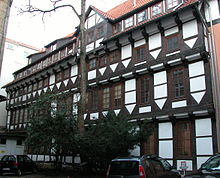Russian Embassy (Braunschweig)
The half-timbered house, popularly known as the Russian Embassy and under monument protection , is located at Jakobstrasse 1a in Braunschweig's Weichbild old town . It was built in 1561 and is the largest wooden building in the city that was spared from damage during the Second World War and is still preserved today.
history
In 1561 Jobst Kale († 1584), mayor of the old town, and his wife Anna Wolemann († 1588) had a three - story half - timbered house built for themselves between Jakobstrasse and today's Bankplatz . The house served as a residential and storage building. The front side and original entrance side of the building is the south side facing the inner courtyard of the building at Bankplatz 8. On this side of the facade is the motto of the Reformation , written in Latin capital letters, "VERBUM DOMINI MANET IN ETERNAM AMEN" [sic!] ( The Lord's word lasts forever, amen ) as well as the dating and the coats of arms of the builder and his wife. The north side of the house is unadorned.
Around 1711 a large hall was built in the building, which is two floors high, was refurbished in the first half of the 19th century and still exists today. The house was built from 1866 to 1970 by the publishing house and printer Joh. Heinr. Meyer used. When the company had an additional residential and commercial building built on Jakobstrasse in 1902, the entrance to the half-timbered house was moved to the north side.
"Russian Embassy"
The great hall is said to have served as the residence of the special envoy of the Russian Tsar Peter the Great during a long stay in Braunschweig . The special envoy was in town to negotiate a marriage contract , as Charlotte Christine von Braunschweig-Wolfenbüttel , second daughter of Duke Ludwig Rudolf of Guelph and niece of Duke Anton Ulrichs, was to be married to Tsarevich Alexej Petrovich . After the negotiations were successfully concluded, the wedding took place in Torgau on October 14, 1712 in the presence of Tsar Peter the Great .
Former student residence
In 1970 the Studentenwerk Braunschweig acquired the building, had the house on Jakobstrasse demolished and the half-timbered house converted into a dormitory for student couples based on designs by the Braunschweig architect Justus Herrenberger . 19 apartments were built and the large hall was restored . The apartments on the two attic floors can also be reached via a fire-resistant stair tower that is also attached to the north side of the house. The massive tower is partially clad with half-timbering. The threshold beam on the first floor of the tower shows from left to right the Lower Saxony horse , the federal eagle , the year 1972 and the Braunschweig lion as a reference to the sponsors of this dormitory building. The lugs above this floor are decorated with carved oak figures. The cellar room, which consists of a double barrel vault , was prepared in such a way that it can be used as a playground for children in bad weather, but can also be used as a party room. The dormitory opened on February 23, 1973. In 2011 the student union sold the building, which has not been used as a student residence since then.
While the house was a student residence, the hall was occasionally used for cultural events such as B. used concerts.
Impressions
Carvings: The studs show couples in love. The threshold bar below shows v. l. Right: the Sachsenross, the federal eagle, the year 1972 and the Braunschweig lion.
Charlotte Christine von Braunschweig-Wolfenbüttel : Your marriage contract is said to have been negotiated in the "Russian Embassy".
literature
- Rudolf Fricke : The community center in Braunschweig. In: The German community center. Volume 20, Ernst Wasmuth, Tübingen 1975, ISBN 3-8030-0022-X .
- Justus Herrenberger , Alfred Kuhlenkamp, Karl Heinz Loschke: The first dormitory for student couples and the history of the building , In: Contributions to the history of the Carolo-Wilhelmina. Writings of the Braunschweiger Hochschulbund , Volume 6, Verlag Braunschweiger Hochschulbund e. V., Braunschweig 1978.
- Wolfgang Kimpflinger: Monument topography Federal Republic of Germany . Architectural monuments in Lower Saxony , Volume 1.1 .: City of Braunschweig , Part 1, Hameln 1993, ISBN 3-87585-252-4 .
- Norman-Mathias Pingel: Russian Embassy. In: Luitgard Camerer , Manfred Garzmann , Wolf-Dieter Schuegraf (eds.): Braunschweiger Stadtlexikon . Joh. Heinr. Meyer Verlag, Braunschweig 1992, ISBN 3-926701-14-5 , p. 198 .
Individual evidence
- ↑ a b Camerer, Garzmann, Schuegraf, Pingel: Braunschweiger Stadtlexikon , p. 198
- ↑ a b Wolfgang Kimpflinger: Monument topography Federal Republic of Germany. Monuments in Lower Saxony , Volume 1.1 .: City of Braunschweig , Part 1, p. 91
- ↑ Horst-Rüdiger Jarck, Dieter Lent et al. (Eds.): Braunschweigisches Biographisches Lexikon: 8th to 18th centuries , Appelhans Verlag, Braunschweig 2006, ISBN 3-937664-46-7 , p. 138
- ↑ Bellin, Günter: Braunschweig, Jakobstraße 1a, dormitory for student couples , Ed. Justus Herrenberger, Braunschweig, 1973
- ^ A b Karl Heinz Loschke: Social buildings of the Studentenwerk Braunschweig: Jakobstraße dormitory for student married couples , In: Städtforum Braunschweig , p. 161
- ^ Justus Herrenberger, Alfred Kuhlenkamp, Karl Heinz Loschke: The first dormitory for student couples and the history of the building , In: Contributions to the history of the Carolo-Wilhelmina. Writings of the Braunschweiger Hochschulbund , Volume 6, Verlag Braunschweiger Hochschulbund e. V., Braunschweig 1978
- ^ Chronicle of the city of Braunschweig for 1973
Web links
Coordinates: 52 ° 15 ′ 42.2 ″ N , 10 ° 31 ′ 7.5 ″ E







